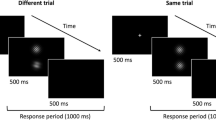Abstract
In the present study we explored the impact of task-irrelevant emotive picture stimuli on visuo-spatial vigilance. Ninety-five participants completed the experiment in which task-irrelevant emotive picture stimuli were embedded in the vigilance task. Four experimental groups were tested by combining two levels of picture valence, positive versus negative, and two levels of picture arousal, arousing versus non-arousing, for the picture stimuli. The task was organized so that baseline performance, the initial impact of the images, and any continual carry-over effects of the images on performance could be measured. In addition to performance on the task, subjective state was measured using a self-report questionnaire designed to examine energetic and tense arousal as well as task-related and task-unrelated thoughts. The performance decrement of the groups exposed to the arousing picture stimuli was attenuated in comparison to those exposed to the non-arousing stimuli. Further the relationship between self-reported energetic arousal and performance differed for the arousing and non-arousing picture groups. Post-task energetic arousal significantly predicted the performance decrement for the arousing picture group, but not for the non-arousing picture group. These results provide support for the perspective that the arousal quality of picture stimuli matters more for performance than valence, and that arousing pictures while possibly disruptive when presented concurrently with the vigilance task may result in improved performance later due to an increase in energetic arousal.






Similar content being viewed by others
References
Anderson, A. K., & Phelps, E. A. (2001). Lesions of the human amygdala impair enhanced perception of emotionally salient events. Nature, 411, 305–309.
Bradley, M. M., Greenwald, M. K., Petry, M. C., & Lang, P. J. (1992). Remembering pictures: pleasure and arousal in memory. Journal of Experimental Psychology: Learning Memory and Cognition, 18, 379–390.
Bradley, M. M., & Lang, P. J. (2007). The international affective picture system (IAPS) in the study of emotion and attention. In J. A. Coan & J. J. B. Allen (Eds.), Handbook of emotion elicitation and assessment (pp. 29–46). Oxford: Oxford University Press.
Brisswalter, J. B., Collardeau, M., & Arcelin, R. (2002). Effects of acute physical exercise characteristics on cognitive performance. Sports Medicine, 32, 555–566.
Brunyé, T. T., Mahoney, C. R., Augustyn, J. S., & Taylor, H. A. (2009). Emotional state and local versus global spatial memory. Acta Psychologica, 130(2), 138–146.
Caggiano, D. M., & Parasuraman, R. (2004). The role of memory representation in the vigilance decrement. Psychonomic Bulletin & Review, 11(5), 932–937.
Chang, Y. K., Labban, J. D., Gapin, J. I., & Etnier, J. L. (2012). The effects of acute exercise on cognitive performance: a meta-analysis. Brain Research, 1453, 87–101.
Clifford, B. R., & Hollin, C. R. (1981). Effects of the type of incident and the number of perpetrators on eyewitness memory. Journal of Applied Psychology, 66(3), 364.
De Joux, N., Russell, P. N., & Helton, W. S. (2013). A functional near-infrared spectroscopy study of sustained attention to local and global target features. Brain and Cognition, 81(3), 370–375.
Delplanque, S., N’diaye, K., Scherer, K., & Grandjean, D. (2007). Spatial frequencies or emotional effects? A systematic measure of spatial frequencies for IAPS pictures by a discrete wavelet analysis. Journal of Neuroscience Methods, 165, 144–150.
Fischer, T., Langner, R., Birbaumer, N., & Brocke, B. (2008). Arousal and attention: Self-chosen stimulation optimizes cortical excitability and minimizes compensatory effort. Journal of Cognitive Neuroscience, 20(8), 1443–1453.
Fox, E., Russo, R., Bowles, R., & Dutton, K. (2001). Do threatening stimuli draw or hold visual attention in subclinical anxiety? Journal of Experimental Psychology: General, 130, 681–700.
Gray, J. R. (2001). Emotional modulation of cognitive control: approach–withdrawal states double-dissociate spatial from verbal two-back task performance. Journal of Experimental Psychology: General, 130(3), 436.
Green, A. L., Draper, N., & Helton, W. S. (2014). The impact of fear words in a secondary task on complex motor performance: a dual-task climbing study. Psychological Research, 78, 557–565.
Hancock, P. A., & Hart, S. G. (2002). Defeating terrorism: What can human factors/ergonomics offer? Ergonomics and Design, 10, 6–16.
Head, J., & Helton, W. S. (2012). Natural scene stimuli and lapses of sustained attention. Consciousness and Cognition, 21(4), 1617–1625.
Helton, W. S., Dorahy, M. J., & Russell, P. N. (2011). Dissociative tendencies and right hemisphere processing load: effects on vigilance performance. Consciousness and Cognition, 20, 696–702.
Helton, W. S., Kern, R. P., & Walker, D. R. (2009a). Tympanic membrane temperature, exposure to emotional stimuli and the sustained attention to response task. Journal of Clinical and Experimental Neuropsychology, 31, 611–616.
Helton, W. S., Matthews, G., & Warm, J. S. (2009b). Stress state mediation between environmental variables and performance: the case of noise and vigilance. Acta Psychologica, 130, 204–213.
Helton, W. S., & Russell, P. N. (2011). The effects of arousing negative and neutral picture stimuli on target detection in a vigilance task. Human Factors, 53, 132–141.
Helton, W. S., & Russell, P. N. (2012). Brief mental breaks and content-free cues may not keep you focused. Experimental Brain Research, 219, 37–46.
Helton, W. S., & Russell, P. N. (2013). Visuospatial and verbal working memory load: effects on visuospatial vigilance. Experimental Brain Research, 224(3), 429–436.
Helton, W. S., Shaw, T., Warm, J. S., Matthews, G., & Hancock, P. A. (2008). Effects of warned and unwarned demand transitions on vigilance performance and stress. Anxiety, Stress and Coping, 21, 173–184.
Helton, W. S., & Warm, J. S. (2008). Signal salience and the mindlessness theory of vigilance. Acta Psychologica, 129, 18–25.
Hirst, W., & Kalmar, D. (1987). Characterizing attentional resources. Journal of Experimental Psychology: General, 116, 68–81.
Hitchcock, E. M., Warm, J. S., Mathews, G., Dember, W. N., Shear, P. K., Tripp, L. D., et al. (2003). Automation cueing modulates cerebral blood flow and vigilance in a simulated air traffic control task. Theoretical Issues in Ergonomics Science, 4, 89–112.
Ihssen, N., & Keil, A. (2009). The costs and benefits of processing emotional stimuli during rapid serial visual presentation. Cognition and Emotion, 23, 296–326.
Kahneman, D. (1973). Attention and effort (p. 40). Englewood: Prentice Hall.
Keil, A., & Ihssen, N. (2004). Identification facilitation for emotionally arousing verbs during the attentional blink. Emotion, 4, 23–35.
Keppel, G., & Zedeck, S. (2001). Data analysis for research designs. New York: W.H. Freeman & Co.
Kern, R. P., Libkuman, T. M., & Otani, H. (2002). Memory for negatively arousing and neutral pictorial stimuli using a repeated testing paradigm. Cognition and Emotion, 16, 749–767.
Kern, R. P., Libkuman, T. M., Otani, H., & Holmes, K. (2005). Emotional stimuli, divided attention, and memory. Emotion, 5, 408–417.
Knebel, J. F., Toepel, U., Hudry, J., le Coutre, J., & Murray, M. M. (2008). Generating controlled image sets in cognitive neuroscience research. Brain Topography, 20, 284–289.
Lambourne, K., & Tomporowski, P. (2010). The effect of exercise-induced arousal on cognitive task performance: a meta-regression analysis. Brain Research, 1341, 12–24.
Lang, P. J., Bradley, M. M., & Cuthbert, B. N. (2001). International Affective Picture System: Instruction manual and affective ratings (Tech. Rep. No. A-5). Gainesville: University of Florida, Center for Research in Psychophysiology.
Langner, R., Willmes, K., Chatterjee, A., Eickhoff, S. B., & Sturm, W. (2010). Energetic effects of stimulus intensity on prolonged simple reaction time performance. Psychological Research, 74, 499–512.
Loftus, E. F., & Burns, T. E. (1982). Mental shock can produce retrograde amnesia. Memory & Cognition, 10(4), 318–323.
Macmillan, N. A., & Creelman, C. D. (2005). Detection theory: A user’s guide. Mahwah: Erlbaum.
Matthews, G., Campbell, S. E., Falconer, S., Joyner, L. A., Huggins, J., Gilliand, K., et al. (2002). Fundamental dimensions of subjective state in performance settings: task engagement, distress, and worry. Emotion, 2, 315–340.
Matthews, G., Davies, D. R., & Lees, J. L. (1990). Arousal, extraversion, and individual differences in resource availability. Journal of Personality and Social Psychology, 59, 150–168.
Ohman, A., Flykt, A., & Esteves, F. (2001). Emotion drives attention: detecting the snake in the grass. Journal of Experimental Psychology: General, 130, 466–478.
Ossowski, U., Malinen, S., & Helton, W. S. (2011). The effects of emotional stimuli on target detection: indirect and direct resource costs. Consciousness and Cognition, 20, 1649–1658.
Ross, H. A., Russell, P. N., & Helton, W. S. (2014). Effects of breaks and goal switches on the vigilance decrement. Experimental Brain Research, 232, 1729–1737.
Ruxton, G. D., & Beauchamp, G. (2008). Time for some a priori thinking about post hoc testing. Behavioral Ecology, 19, 690–693.
Shackman, A. J., Sarinopoulos, I., Maxwell, J. S., Pizzagalli, D. A., Lavric, A., & Davidson, R. J. (2006). Anxiety selectively disrupts visuospatial working memory. Emotion, 6(1), 40.
Shaw, T. H., Warm, J. S., Finomore, V., Tripp, L., Matthews, G., Weiler, E., et al. (2009). Effects of sensory modality on cerebral blood flow velocity during vigilance. Neuroscience Letters, 461, 207–211.
Temple, J. G., Warm, J. S., Dember, W. N., Jones, K. S., LaGrange, C. M., & Matthews, G. (2000). The effects of signal salience and caffeine on performance, workload and stress in an abbreviated vigilance task. Human Factors, 42, 183–194.
Tomporowski, P. D. (2003). Effects of acute bouts of exercise on cognition. ActaPsychologica., 112, 297–324.
Warm, J. S. (1984). An introduction to vigilance. In J. S. Warm (Ed.), Sustained attention in human performance (pp. 1–14). Chichester: Wiley.
Warm, J. S., Parasuraman, R., & Matthews, G. (2008). Vigilance requires hard mental work and is stressful. Human Factors, 50, 433–441.
Zeelenberg, R., Wagenmakers, E. J., & Rotteveel, M. (2006). The impact of emotion on perception: Bias or enhanced processing? Psychological Science, 17, 287–291.
Author information
Authors and Affiliations
Corresponding author
Rights and permissions
About this article
Cite this article
Flood, G., Näswall, K. & Helton, W.S. The effects of emotional stimuli on visuo-spatial vigilance. Psychological Research 79, 861–871 (2015). https://doi.org/10.1007/s00426-014-0609-x
Received:
Accepted:
Published:
Issue Date:
DOI: https://doi.org/10.1007/s00426-014-0609-x




